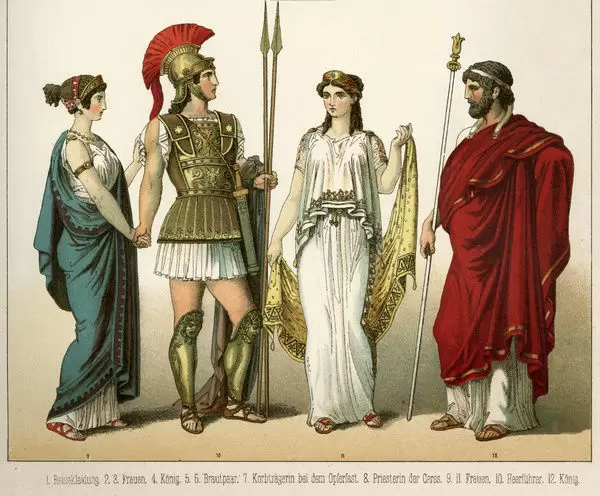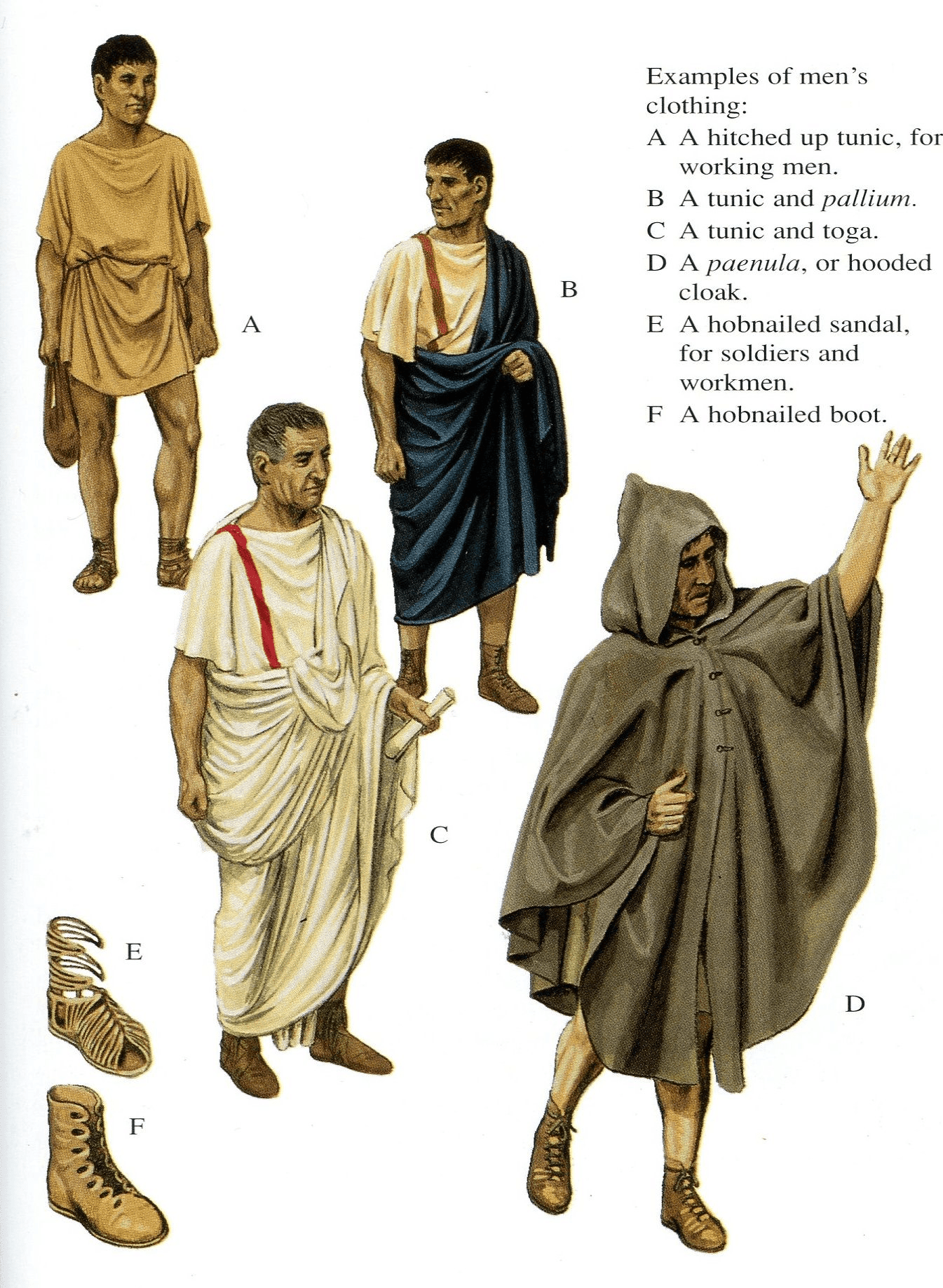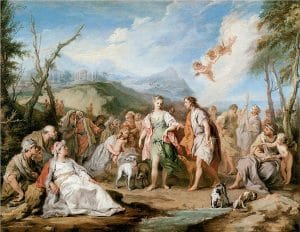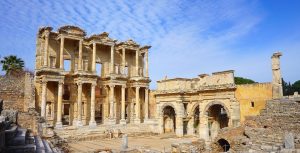Clothing and Fashion, jewelry, shoes, and hairstyle in Ephesus
How did the Ephesians, who were on the trade routes between Europe and Asia and were a large import and export center with its port, dress in the ancient world? How did they create their fashion? Who were they influenced by in their clothing, appearance, and personal belongings, or who did they set an example for? What were the rules of dressing and dress code, which had an important place in the lives of Ephesians, one of us, and what did they pioneer?
Clothing, Fashion, Jewelry, Shoes in Ephesus
Preferred clothing in Ephesus
The ancient city of Ephesus, which was ahead of its time, was very advanced in both trade and fashion. They were designing new products with their constantly improving craftsmen and tailors, and by realizing them, they attracted the attention of the rich, middle, and poor people. But before getting into the Dress in Ephesus, let’s look at how the concept of dressing developed in the ancient world and who pioneered it.

Five thousand years ago there lived a tailor in Egypt. The tailor bears the name Hermes Tut in Egyptian papyri. According to the Qur’an, he is the third prophet, Idris, after Adam and his son Seth. He was the first person to write with a pen and sew clothes. The thought of the tailor Hermes, which sheds light on all intellectual currents after him, is this: “People are mortal gods, gods are immortal people”
It is claimed that Idris is the same person as Enoch in the Tanakh. Enoch is a descendant of Seth, son of Adam, and lives 365 years. At the end of his life, he disappears by walking with God, that is, he does not die. According to the ancient Greeks, he is Trismegistus (Three times a saint, the Greeks also gave this name to Hermes, which means he was blessed three times.) Besides being the founder of astrology and alchemy, he wrote with a pen and sewed. thorn is the first human.
What we know about clothes and jewelry in Ancient Ephesus, we obtain from archaeological finds such as sculptures, reliefs, vase paintings, mosaics, frescoes, ancient literature, and temple inventories. Archaeological finds show not only the clothing of heroes, gods, emperors, and the elite but also the clothing of poor people, especially since the Hellenistic period.
In ancient literature, for example, Homer, Iliad, and Odyssey describe the clothing and jewelry of the heroes. Again M.S. The dresses of comedians are introduced in the work of Pollux, which dates back to the 2nd century, “Onomasticon” (a work of 10 volumes and encyclopedia value).
In the archaic period in Ephesus, women used to wear a garment called Peplos. Peplos consisted of a rectangular cloth woven from wool. The fabric was folded ½ at chest level to keep the breasts warm. Peplos, which went down to the feet, had 2 types, open and closed. In closed Peplos, the right and left sides were kept completely closed, leaving an opening for the arms.
In open Peplos, the right side of the body was usually closed, and the left side was open. On the open side, the four ends of the fabric were gathered and hung down. The required fabric size for a Peplos was 2X3 meters. Peplos was worn as a single garment during the times it was used, and no second clothing or underwear was worn inside.
While women wore Peplos, men wore Chlaina, a type of coat. Chlaina was a rectangular fabric made of wool. The single-story one was called Haplois, and the double-story one was called Diplax.
Anatolian cities determined fashion in the Archaic period. Because the Anatolian cities had more frequent contact with the eastern cities with high culture and were richer than the Hellenic ones. As a result of this activity of Anatolian cities in fashion, Peplos was quickly abandoned. From the beginning of the 6th century, a garment called Chiton became very famous.
The origin of the chiton dress is Ionian. When Homer talks about the Ionians, he says “Ionians wearing chiton skirts sweeping the floor”. So who are these Ionians; The 12 Ionic cities are;
Miletus, Myus, Priene, Ephesus, Colophon, Lebedos,
Teos, Erythrai, Klazomenai, Phokaia, Samos, and Chios.
The chiton was hung down like a fan from the places it was attached to with buttons, and lead or ceramic weights were hung on the ends to create beautiful pleats on the hanging ends. The amount of fabric required for a Chiton was 2X4 meters. The chiton was first worn by men and later by women in Ionia and Ephesus.
The origin of word Chiton comes from the Semitic language. The main material of chiton is linen.

The garment had a cylindrical form formed by two rectangular pieces of fabric. Two pieces of fabric were fastened with buttons on the shoulders.
In the Archaic period, only travelers, soldiers, and craftsmen wore short Chitons and others wore long Chitons. In the classical period, the city that put its weight on fashion was Ephesus. In Ephesus, the classical period combined the Ionic and Doric lines, and the Chiton was worn wider and more draped than in the archaic period.
In the Classical period, only theater actors, priests, and charioteers wore the long Chiton, while the others wore the short Chiton. In the Hellenistic period, the city of Ephesus determined fashion. The only difference between the Hellenistic Chitons and the previous ones is that the belts that the women wore on the Chiton were tied higher up and closer to the chest. Also, most Chitons were made sleeveless during this period.
Men and women wore a top on the Chiton from the 6th century BC, which was called the Himation. The himation was a cross-knit mantle. It was usually wrapped around the body in two ways: by bringing both ends forward, or by wrapping one end around the waist, under the left arm, and throwing it over the right shoulder. The front and rear ends were hanging down freely.

These two garments, Chiton and Himation, were the most preferred clothes of the Ephesians during the Roman period, as the two main garments of the Hellenic world and Ephesus. Apart from these was Khlamys, who had a lighter mantle than Himation and was attached to one shoulder with a fibula (a type of safety pin).
Due to their comfort, chlamys is mostly adopted and worn by young people, soldiers, and travelers. Khlamys, which had a rectangular form in the Classical period, was produced in an oval shape in the Hellenistic period.
Working workers, slaves, and soldiers often wore a garment called Eksomis. It was a knee-length garment fastened by a fibula at the shoulders, exposing the arms and right chest.
The colors and patterns of the fabrics changed over time. In the archaic period, colorful fabrics became fashionable and fabrics with different patterns were produced. From the first quarter of the 5th century BC, monochrome (white) and unpatterned fabrics became fashionable.
At that time, the pioneer of fashion in Anatolia was the ancient city of Ephesus. Ephesians’ clothing preferences were especially influential in other cities, especially in the Ionian cities, and also in ancient cities. In the Hellenistic period, the polychrome and patterns of the archaic period were returned, and clothes made of transparent fabrics were preferred to woolen and linen fabrics in this period.
At that time, transparent fabrics were only made of silk. Silk was brought from east to west Anatolia as raw silk in those times and processed there and sold to the world of Ephesus and Hellenes. The most well-known silk-producing city was the island of Kos.
Preferred hats in Ephesus
Often a portion of the Himation was pulled to the head for protection from rain and sun. But there were some types of hats to protect the head. Pilos is a conical hat made of felt and was mostly worn by peasants, shepherds, hand workers, and craftsmen. Petasos is a wide-brimmed hat tied around the neck with a band and was mostly worn by travelers and hunters.
Tholia was a hat similar to Petasos worn by women. Causia is a flat-shaped, beret-like hat, first worn only by the rich and later by the poor. Tiara was a half-shaped, flat-top hat made of felt, mostly worn in Anatolia.

Preferred shoes in Ephesus
Ephesians used to walk barefoot in their early days. They began to wear sandals in the archaic age. The most common type of shoe from the Archaic age, Sandal, consisted of a sole worshiped from cowhide and thongs connecting this sole to the feet. It has been worn mostly by women since the classical age.
B.C. At the beginning of the 6th century, shoes called Kothornus, which were mostly worn by Ephesians, Ionian cities, and Lydians, became fashionable. The noses of Kothornus were pointed and upturned. In addition, the sole of the shoe covers it completely, sometimes even up to the ankles. Kothornus has been a shoe preferred by both men and women in Ephesus.
Another shoe is Krepis. This shoe is half sandal half form, mostly worn by travelers and hunters. Apart from these shoes, the boot worn especially on muddy days was called Endromis. The upper of the Endromis would go up to below the kneecap, and it was also tied with ribbons.
The shoes were mostly made of calf and goat leather. Ephesian women preferred yellow, white, and red, colored shoes. They walked around the house barefoot and wore shoes when going out.
Preferred jewelery in Ephesus

In Ephesus, while the rich had their jewelry made of gold, the poor and middle class had their jewelry made of bronze, glass, and terracotta covered with gold gilding. We learn from ancient sources that in the Archaic period, men wore jewelry as well as women. These include chains, fibulae, bracelets, and rings. The fibula was an ornament, but also a functional piece of jewelry. Fibulae were made in different forms in different periods.
Bands used by Ephesians in Ephesus: Women and young people used to tie bands on their heads. Thin bands were called Taenia, wide bands were called Mitrene. The bands were looped and knotted fifteen times. It is known that pearls were tied to the ends of the knots in the Hellenistic period. We know that in the Olympics and some competitions, young male athletes tie bands on their heads in this way. In the Hellenistic period, these bands were replaced by diadems.
Apart from this jewelry, women wore earrings that resulted in half moon, rosette, and animal motifs. Bracelets were a rare piece of jewelry for modern times. In ancient times, the bracelet was not worn on the wrist, but on the biceps. Bracelets with snake-shaped ends were the most popular.
Rings were often made with engraved stones. These rings were also used by men as seals.
Preferred clothing in Ephesus in the Roman Period
In the ancient city of Ephesus, clothing was determined by laws in the Roman period. For example, only Roman citizens could wear Toga. Non-freedoms and non-Roman citizens were forbidden to wear the toga. The color, width, and borders of the toga would be different for commoners and nobles. The toga, which was usually narrow in Ephesus, was extremely wide and draped during the imperial period.
The toga consisted of a half-round elliptical fabric. It was wrapped around the body in different ways. The length of the fabric of the togan was three times the length of the man up to the shoulder. In the imperial period, the toga was worn by the people only on holidays, sacrifices, and official occasions.
Tunica: The main garment of the Romans was the Tunica. Tunica was previously produced from a cotton and wool blend fabric.
While men wore a single tunic, women wore two tunics on top of each other.
The tunic consisted of two parts, fastened at the front and back. Women wore long tunics and men wore short tunics.
They called the long tunic worn by women “Tunica Talaris”. It was not acceptable for men to have the tunic come down to the feet.
Tunica was produced as sleeveless or short-sleeved. It was also tightened with a belt over the hip.
The tunic worn by women was called Tunika Subucula, and the ones they wore on top were called Tunica Talaris.
Freeborn Ephesian women wore a top called Stola over a tunic. The stolas of married women had buttons on their sleeves.

Other than the tunica, the other clothes worn by the Ephesians during the Roman period are;
Paenula: It was a top that was worn over the tunic. It was a conical, sleeveless, cape-like garment with a V-shaped opening for the head to pass through. While this garment was worn only by the nobles, it started to be worn by the poor people during the time of the emperor Trajan (AD 98-117). Women’s Paenulas were longer than men’s.
Lacerna: Similar to Helen’s Khylamys, it began to be worn in the 1st century BC. During the imperial period, it became fully wide-spread. Lacernas are made of bright and colorful fabric with a half-round forum and are worn as a raincoat.
Cucullus: It was a bag-shaped garment that stretched from the neck to the knees, mostly worn by slaves and workers. This garment, taken from the Galians, was usually brown.
Dalmatika: This dress, which originated in Anatolia, was the main dress of the Christians. It became very common after Christianity was accepted as the official religion of Rome in the 4th century AD. It was a garment without a belt, with wide and long sleeves reaching to the feet. With this dress, women used headscarves instead of tops.
Pelles Manicata: It was a sheepskin hide worn by shepherds and slaves. Apart from these clothes, the Ephesian soldiers of the Roman empire wore a kind of trousers that went down to the knee from the first period. Wearing pants is M.S. It has been in fashion since the 3rd century, M.S. It was banned in 397 by the emperors Honorius and Arcadius. However, this ban was unsuccessful.
It is known that women who do not wear underwear use a corset and a bra-like breastplate. In the bright times of the Roman period of Ephesus, only women preferred colored fabrics, while men preferred colored fabrics in the later periods. According to the information we have obtained from the frescoes, the leading colors preferred by women are blue, saffron yellow, light green, and lilac. In addition to cotton fabrics, tunics were made from expensive transparent silk fabrics, especially in the imperial period. The clothes of slaves were fabricated.
Generally, wool, linen, and cotton fabrics were used in the making of clothes. The best quality wool was exported from Miletus, and the best quality linen from Laodicea, Tarsus, Damascus, and Alexandria was exported to all Mediterranean cities. Silk was imported from China. Due to its high price, it was mixed with cotton. Silk fabric mixed with cotton was called “Subserica”.
Women mostly preferred silk fabric. Women’s clothing made of pure silk was called “Holosericum”. Men were forbidden by Tiberius to wear silk cloth. The price of a kilo of raw silk was 8 aurei in the years (14 – 37 AD).
A.D. At the end of the 3rd century, 1 kg in the emperor Diocletian’s edict. The price of pure silk is fixed at 12,000 Denari (silver coins). Emperor Justinian I, on the other hand, monopolized the purchase and sale of silk and increased the price of silk to 72 Aurei, which at that time sold 1 kg of silk sellers to 16 Aurei (gold coins).
Preferred hats in Ephesus in the Roman Period
During the Roman period, the Ephesians did not wear hat in their daily lives except for official ceremonies and sacrificial ceremonies. In ceremonies, they would pull some of their togas over their heads.
Petasos: It was taken from the Hellenic world and was mostly worn by the rich. Pilleus: It was a conical hat in the form of a cone worn only by slaves. Apart from this, after the 3rd century AD, a hat similar to the Causias of the Hellenes became very fashionable.
Preferred shoes in Ephesus in the Roman Period

Celceus: It was the type of shoe that the Ephesians wore most during the Roman period.
This shoe reached up to the ankle. It was in different colors and made of soft leather.
The clothes worn by the women of Ephesus were called Calcei and were produced only in white.
Caliga: It was a sturdy shoe worn by soldiers, farmers, and workers. The soles were hobbed and the upper consisted of several pieces.
Pero: It was a kind of boot that was worn mostly in mud and terrain, that gripped the feet up to the ankles.
Solea/Sandalia: They were sandals worn indoors only. You couldn’t go out with them.
Preferred hair and beard in Ephesus in the Roman Period
In the Roman period, the first cut hair and beards of Ephesian children were presented to the gods. For this reason, the gods were prayed to and sacrificed in ceremonies. Although this tradition originally belonged only to the families of the people who were at the head of the city administration, it later became property.
Ephesian men generally did not grow beards. Only on days of mourning did they not cut their beards.
During the reign of Emperor Hadrian (A.D. 117 – 138), it became fashionable for men living in Ephesus to grow a beard and this continued until the beginning of the 4th century A.D. The hair of the women of Ephesus was gathered in a bun on the back of the head with a hairpin called “Nodus”. Every other hairstyle was contrary to tradition.
Women who let their hair loose were not looked upon well. The hairstyles of the Roman empresses also determined the fashion of the women of Ephesus, their hairstyles spread to every city of the empire with the coins they minted in their names and were immediately adopted by the women.
M.S. It is known that some men and women from Ephesus had their hair dyed or wore wigs when blonde hair became fashionable in the 2nd century.
Preferred jewelry in Ephesus in the Roman Period
The jewelry used in the early periods of Ephesus was also used in the Roman period. Apart from the jewelry used in the early days of Ephesus, the necklace called “Monile”, the neck chain called “Catellae” and the foot bracelets called “Khalkhals” were used as jewelry. More and various pieces of jewelry were produced and used in the Roman period of Ephesus compared to the previous Hellenic period. The reason for this was the fondness of the Ephesian women living in the Roman period for jewelry.
Gold and precious stones were coming to Ephesus mostly from the east.
Opal, sapphire, emerald, topaz, ruby, and diamond are among the stones documented to have been imported from Ephesus during the Roman imperial period. In addition to these, pearls were among the most popular jewelry. Wealthy women of Ephesus carried many precious jewels. It gives the value scale of the stones of the jewelry made for the rich at that time as diamonds, emeralds, beryl, opal, sardonix.

In ancient times, gold was usually processed pure (983 carats). The processing technique of gold was no different than today. At that time, granulation, forging, casting, and watermark techniques were known.
The greatest masters of jewelry were of Egyptian and Mesopotamian origin. The masters who came from here taught their skills to the Anatolian masters, and they to the Ionian and Ephesian masters.
All the things done to beautify Ephesus was called Cultus in the Roman period. This term consists of 2 words “Mundus = to be painted” and “Ornatus = to include jewelry”.
The materials used by the women of Ephesus who lived in the Roman period for dyeing were various creams obtained from plants, barley flour, ground shell fruits, eggs, rosin, ground staghorn, calendula bulbs, honey, olive oil, roasted beans, egg whites, and iris.
While the men of Ephesus used the scent of rosin (resin) and cinnamon as perfume, the women wore many different scents.





